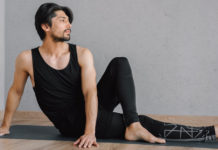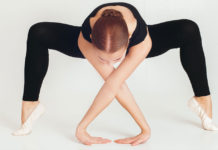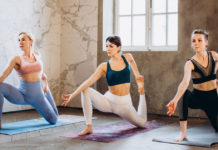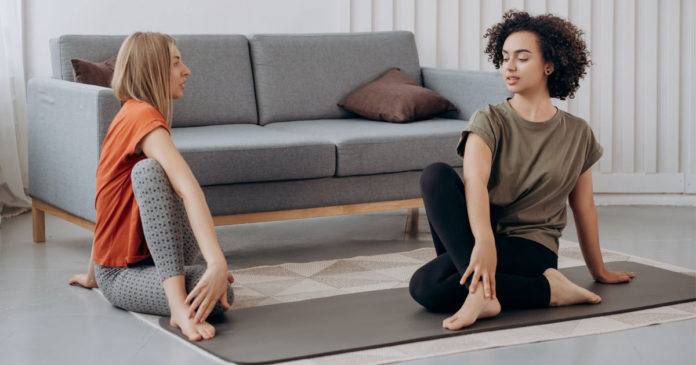Engaging in yoga movements in the company of another individual is referred to as partner yoga, couple yoga, or acro yoga. It’s an interesting and different practice. It has the added benefit of fostering relationships and trust between couples in addition to all the health advantages of regular yoga. We will explore partner yoga and different yoga poses for two people in more detail as well as all of its wonderful advantages in this article.
Partner yoga postures are designed to be performed by two persons who can work together harmoniously. Whether a posture is a basic stretch or a more complex athletic action depends on the practitioners’ comfort and ability level. By practicing these yoga poses for two people together, partners may improve their communication, build trust, and deepen their relationship.
You get greater flexibility with group yoga and yoga poses for two people, which is one of its biggest benefits. Together, you may push each other into postures that you would find challenging on your own while practicing with a partner. Being more mobile and adaptable in general is made possible by this.
Not only do yoga poses for two people increase your flexibility, but it also builds your strength. Most couple poses need both partners to utilize their muscles to maintain stability and balance. Your arms, legs, core, and back may all get stronger with these exercises.
Furthermore
Furthermore, partner yoga is beneficial not only for your physical health but also for your emotional well-being. By doing yoga poses for two people, couples find it simpler to communicate and feel connected when they engage in this technique. It needs collaboration and trust, which may strengthen relationships both on and off the mat.
There are several variations of partner yoga based on your requirements. You might just get extra practice out of it or it can be a pleasant activity to perform with your spouse. Everyone who wishes to experience this unique kind of group exercise may do anything from simple stretches to challenging acrobatic maneuvers or yoga poses for two people or more.
We’ll go into greater detail regarding certain partner yoga positions as well as the advantages this practice provides for individuals and couples in the sections that follow. This is the perfect moment to go on an exciting journey into the realm of partner yoga. Find a new friend or companion that shares your passion for exploration.
Understanding the Basics: Essential Tips and Safety Precautions for Partner Yoga
Yoga with a partner is an excellent method to get the advantages of yoga while having a person’s support and companionship. To ensure that partner yoga is both safe and enjoyable, you need exercise caution and adhere to some safety guidelines before doing complex yoga poses for two people.
Starting out with a partner in yoga that you feel comfortable and confident with is crucial. It is crucial to communicate throughout the session, so be sure to discuss any physical limitations or health concerns beforehand.
Select yoga postures for two people that are appropriate for your combined ability and flexibility levels if you practice with a partner. As you gain greater trust and understanding from your partner, go to more challenging postures that gently strain you.
In partner yoga, it’s important to be aware of each other’s boundaries and safety zones. Always be aware of your body’s signals, and if anything doesn’t feel right, inform someone right away. Avoid overstressing your joints or forcing yourself into uncomfortable yoga poses for two people as you can fall over or get injured.
When doing stretches and yoga poses for two people, it’s also critical to maintain your posture straight. Observe good technique and ensure that both partners are providing appropriate support to each other to prevent straining or overextension of any muscles.
Not to mention, before attempting any yoga poses for two people, remember to warm up. This reduces the chance of injury and prepares the body for movement. Using a cool-down strategy at the conclusion of your workout might also help you unwind and recuperate.
You may begin a fulfilling partner yoga practice and constantly prioritize your health by paying attention to these crucial safety guidelines and recommendations.
21 Energizing Yoga Poses for Two People to Strengthen Your Bond and Flexibility
Yoga is a fantastic approach to strengthen your connection with your spouse. It may also improve your flexibility and overall wellness. You can begin moving with these 21 yoga poses for two people:
1. Seated Forward Fold
A yoga stance that stretches the spine, hamstrings, and lower back is called the Seated Forward Fold. It also increases flexibility. To make the stretch deeper, you should sit across from each other with your legs stretched out in front of you. This position assists with stress reduction, mental clarity, and posture correction. It also releases tension in the neck and back. You may alter it by adding props like straps or blocks. It’s critical to pay attention to your body’s signals, take deep breaths, and relax your muscles. Relaxation and flexibility may improve with regular practice.
2. Double Downward Dog
In the yoga stance known as Double Downward Dog, two people face each other in the downward dog position, which increases flexibility, balance, and strength. Assume the downward dog position, placing palms shoulder-width apart and ankles hip-width apart, to initiate the pose. The hips are straightened out and raised toward the ceiling. To ensure safety and proper alignment, one might put their foot on top of the other’s back; this requires communication and confidence. Applying pressure might deepen the stretch for the individual whose feet are on the upper back. Sufficient shoulder stability, flexibility, and core strength are necessary for this position. It is important to warm up before trying, and consulting an experienced teacher is advised.
3. Double Tree Pose
A difficult yoga practice that calls for balance and cooperation between two people is the double tree pose. It entails raising the leg on the same side against the inner thigh of the other while standing side by side and facing opposite directions. Posing in this manner encourages communication, trust, flexibility, and physical strength. Maintaining balance takes concentration, a stable standing leg, and a strong core. The posture helps strengthen partner relationships, increase attention, and increase body awareness. Speaking with your spouse is essential to ensuring alignment and preventing pain. Never try a difficult stance, such as the Double Tree stance, without first warming up and paying attention to your body.
4. Partner Boat Pose
Twisting their knees to face each other, two people do the yoga posture known as the Partner Boat posture. To achieve equilibrium, they grasp hands and elevate their feet above the earth. This position develops trust and connection, strengthens the core muscles, and calls for coordination and communication. With their knees bowed and feet level on the ground, both participants must be seated in order to perform. They need to straighten their backs, steadily raise both feet off the ground, and grasp hands firmly. It’s essential to keep your equilibrium to prevent strain or pain. For an extra challenge, try extending or straightening your legs. All skill levels of yogis may do the Partner Boat Pose as long as there is good communication and alignment between partners.
5. Double Warrior II
In yoga, the Double Warrior II posture is standing next to someone facing the same way, bending the front knee, and stretching the arms out to the sides. Through the possibility for alignment and mutual support, this position enhances strength, flexibility, and balance. Better breathing and posture are encouraged by the outstretched arms, which open up the shoulders and chest. For people of all skill levels, this position may be done alone or as a component of a yoga sequence. It’s important to keep your hips looking forward and your front knee precisely over your ankle. Double Warrior II is a great way to improve both your physical and mental health as well as your relationship and teamwork with your partner.
6. Double Child’s Pose
In the yoga stance known as the Double Child’s stance, you should sit back to back with your partner, bend forward, and extend your arms in front of you. This posture improves the bond between lovers, eases tension in the shoulders and back, and encourages relaxation. Your backs should contact the floor as you begin the posture. Next, contract your core muscles. Allow your upper body to collapse over your legs as you exhale by bending forward from the hips. Keeping your hands on your partner’s back, extend your arms in front of you. For a few breaths, stay in this posture, allowing yourself to deepen and relax if you’d like. To make sure your partner is comfortable and supportive, talk to them. As you hold the Double Child’s Pose, your spine and shoulders will stretch, your lower back and hips will feel better, you’ll rest and feel less stressed, and you and your partner will feel more connected.
7. Double Camel Pose
In the yoga pose known as the Double Camel Pose, two people kneel facing each other, elevate their chests, lean back, and reach back to grasp onto each other’s ankles. Balance, adaptability, mutual trust, and communication are necessary for this stance. on execute, drop on your knees, reach back to grasp each other’s ankles, and stretch your arms behind you. Lean back gently while maintaining your forward gaze, contracting your core muscles and raising your chest toward the sky. This position strengthens communication skills, improves posture, and stretches the front of the body deeply. It’s crucial to proceed cautiously with this position, however, if you have any injuries or flexibility issues already. Pay attention to your body’s signals and change or avoid any movements that hurt or create discomfort. If you are new to yoga or have safety concerns, warm up before trying any postures and speak with a competent teacher.
8. Double Plank Pose
Two individuals in plank position face one another in the Double Plank Pose, an arduous yet rewarding yoga posture. Posing entails extending arms and using the core muscles while keeping the body parallel to the floor. Assembled on all fours, with legs extended behind the backs, both participants ought to commence the exercise while ensuring appropriate alignment and abdominal muscle engagement to support balance and stability. In addition to strengthening core muscles and enhancing general body awareness and stability, the position has many positive effects on both physical and mental health.
It is important to use care while attempting the posture and pay attention to your body’s limitations. Beginners may find it helpful to begin with scaled-down versions or to get advice from a certified yoga teacher. It’s important to practice yoga positions carefully and to the extent of your comfort. It is best to cease doing yoga poses right away and get advice from a healthcare provider if you feel any pain or discomfort when doing any other position.
9. Double Tree Pose Twist
In the yoga pose Double Tree Pose Twist, two people stand next to each other with their backs to the wall and their faces facing the same direction. They twist their bodies toward each other while keeping their balance. Start by standing next to your partner with one foot on top of the other’s inner thigh or leg. Reach up to your shoulders, contract your abs to maintain your balance, and take a breath. Twist your torsos toward each other while maintaining a forward-facing look as you exhale. Hold this pose for a few breaths, then gently release the twist and come back to the center. By swapping legs and turning in the other way, repeat on the other side. Together, you may experience the health benefits of yoga while strengthening relationships, improving communication, and testing your balance in this posture.
10. Double Downward Dog Split
Within the yoga pose of Double Downward Dog Split, two people must work together to stay balanced and coordinated. It entails raising one leg while supporting the other while beginning in the downward dog posture. This position stretches the shoulders, calves, and hamstrings while also enhancing strength, flexibility, and balance. Maintaining good alignment and communication with your partner is essential for performing effectively. Finding stability and balance might need some work. Engaging in this pose with your yoga companion can serve as an enjoyable way to physically challenge yourself and strengthen your connection. As required, modify the stance to ensure comfort and safety by paying attention to your body’s needs.
11. Double High Lunge
An intense yoga practice that works the upper body, core, and legs is the double high lunge. To do this exercise, you and a partner must face the same direction while standing side by side. Then, you must step forward with one foot into a lunge stance while simultaneously raising your arms aloft. This posture calls for balance and coordination as well as strengthening the legs, core, shoulders, and upper body. It may be altered to accommodate varying levels of fitness by changing the lunge’s depth or adding props for assistance. It’s essential to keep your alignment correct to prevent strain or damage. Frequent practice builds trust and communication between partners, increases flexibility, balance, and general body strength, and may be included into fitness regimens for both novice and seasoned yogis.
12. Double Bound Angle Pose
You can also call this pose “Butterfly Pose” or “Double Bound Angle Pose.” It is a sitting yoga pose that is good for your mind and body. It entails two people facing one another, their feet in contact, holding hands, and bending their knees slightly toward the floor. This posture enhances flexibility, improves posture, and stretches the inner quadriceps and lower back, in addition to stretching the pelvis and groin. It facilitates digestion and activates the gastrointestinal organs. Intimacy and a greater feeling of connection with a spouse or fellow yoga practitioner are also promoted by this position. If you have any limits or injuries related to your knees or hips, you should proceed cautiously while attempting this position. It’s important to pay attention to your body’s cues and adjust or skip positions as necessary. Double Bound Angle Pose is beneficial because it releases physical tension, fosters emotional connection, and increases lower body strength and flexibility.
13. Double Warrior III
Balance, strength, and concentration are needed to perform the difficult yoga posture known as Double Warrior III. One leg is extended back and the arms are extended forward by two people who are standing side by side and facing the same direction. They then hinge forward at the hips. This posture is often included into yoga sequences to develop general strength and flexibility. It also strengthens the legs and glutes, increases body awareness, and concentrates the mind.
14. Double Boat Pose Twist
In the Double Boat posture Twist, practitioners of yoga sit facing one another in boat posture, clasp their hands, and twist their torsos in the direction of one another. This position increases flexibility, balance, and develops the core muscles. The correct way to sit for this move is with your legs spread wide, knees bent, and feet lifted off the floor. As you clasp your hands, make sure your grasp is solid. Maintaining a straight spine and uniform pressure, contract your core muscles and progressively rotate your torsos in the direction of one another. Take a few deep breaths and hold the twist while noticing the little stretch in your lower back and waist. Recognize the limits of your body and make necessary adjustments. If you have any current injuries or medical concerns, see a skilled yoga teacher before trying this posture. While doing a strenuous yoga pose like the Double Boat Pose Twist, couples may bond both physically and emotionally.
15. Double Standing Forward Fold
When two people stand shoulder to shoulder, facing in opposite directions, they are in a double standing forward fold, a yoga posture in which they support each other by folding forward at the hips. This position enhances flexibility and balance by giving the lower back and hamstrings a deeper stretch. It may be done as an activity to warm up or as a sequence in yoga. In order to execute the posture, begin by placing yourself and your partner shoulder to shoulder, making sure you have enough room to fold forward comfortably without running into each other. Swing your hips forward and let your upper body fall toward the floor as you release the breath. For stabilization, grasp one another’s arms or shoulders while maintaining a minor bend in the legs to prevent stress on the hamstrings. As you gradually deepen the stretch, unwind around your head and neck. For as long as it is comfortable for both couples, hold this posture for a few breaths. Step out of the stance and take your time getting back to standing.
16. Double Side Plank
A difficult exercise that works the core muscles and calls for balance and coordination is the double side plank. It includes forming a secure basis by placing one foot on top of the other in a side plank stance. This exercise works the shoulders, glutes, and obliques. It becomes harder since you have to interlock your feet. Maintaining appropriate form involves coordination and communication between couples. By varying the time or amount of repetitions, the exercise may be tailored to accommodate individuals with varying levels of fitness. Double side planks may help you develop stronger core muscles, more stability, and better coordination—all while maintaining optimal alignment.
17. Double Bridge Pose
In the yoga pose known as Double Bridge Pose, you will lie on your back with your knees bent and your feet firmly planted on the floor. It requires you to raise your pelvis off the mat in order to form a bridge-like formation with your body. Put your feet on the ground hip-width apart and lie on your back. Flex your knees and engage your glutes as you raise your hips off the floor, making a straight line with your shoulders and knees. For as long as it seems comfortable, hold the posture for a few breaths. Reposition yourself in a restful position by gradually lowering each vertebra at a time. In addition to fortifying and extending the lower back, buttocks, and thighs, this pose reduces tension and enhances posture. If you’re new to yoga or have special concerns, speak with a skilled yoga teacher.
18. Double Cow Face Pose
In the seated yoga posture known as “Double Cow Face Pose,” two people cross their legs and sit with their backs to one another. This position increases flexibility and mobility by offering a deep stretch to the upper back, shoulders, and chest. It expands the hips as well. To practice, take a seat comfortably, cross your legs, and put one arm behind your back. The other person puts out their hand to shake hands. To make sure you are both comfortable and relaxed, talk to your spouse. Posing your body in this manner not only benefits your upper body but also fosters intimacy and enjoyment with your partner.
19. Double Supported Headstand
A powerful, balanced, and trusting partner yoga posture is the Double Supported Headstand. One person assumes the headstand posture while the other holds their partner’s knees to provide support. To guarantee comfort and safety, the posture calls for collaboration, trust, and open communication between partners. While maintaining balance, the supporting companion should refrain from applying excessive pressure to the thighs of their partner while still offering sufficient support. A fun and difficult addition to any couple yoga practice, this posture strengthens the legs, core, and upper body while encouraging cooperation and connection. For correct alignment and technique, practicing under the supervision of a skilled teacher is advised.
20. Double Shoulderstand
As you support each other’s lower backs while laying on your back, you raise your legs toward the sky in the double shoulderstand yoga posture. It calls on partners’ coordination, strength, and balance. To execute, choose a comfortable spot to lay, bend your knees, and rest your hands on the ground for stability. Raise both legs straight up and in unison while grasping each other’s lower backs for support. To keep your balance, contract your abdominal muscles. Benefits of this posture include strengthening the muscles in the core, enhancing balance, extending the shoulders and neck, boosting blood flow, and promoting mental calmness. Exercise carefully, and if necessary, get advice from a certified yoga teacher.
21. Double Savasana
In the yoga stance known as Double Savasana, two people lay down side by side with their bodies totally relaxed, facing the same direction. To enhance the relaxing experience, you may do this exercise with a buddy or partner. Choose a comfortable spot to lay on your back, with your arms outstretched and your palms facing up, to complete Double Savasana. Set your intentions, relax, and concentrate on taking deep breaths and letting go of your thoughts. As you relax further, feel the earth underneath you providing support. This position offers a quiet chance to share a quiet moment while encouraging profound relaxation and renewal for both people. It’s important to pay attention to your body’s demands and modify as necessary to ensure comfort. Take pleasure in this calming position as you relax and rejuvenate in each other’s company.
Embrace the Journey of Connection through Shared Movement with Yoga Poses for Two People
In conclusion, practicing yoga poses for two people with a buddy or partner may be a fulfilling and life-altering experience. Joint movement is a great way for people to improve their friendship or partner connection while simultaneously reaping the physical and psychological advantages of yoga.
Two-person asanas are a unique method to practice harmony, connection, and trust. To achieve these yoga poses for two people, both practitioners must cooperate harmoniously, which fosters a feeling of oneness and connection. Participants in group yoga or in yoga poses for two people can enhance their flexibility, balance, and strength while also developing greater trust with one another.
Practice yoga poses for two people with a partner to improve communication and listening skills. Partners learn how to express what they need clearly and listen intently to each other as they assist one another in various stances. This deeper degree of communication also occurs in daily life, outside of the mat.
Furthermore, practicing yoga poses for two people with a companion may be a great way to spend quality time together. It fosters mutual understanding and laughter as well as words of encouragement and support. People feel more connected to one another and their connections are strengthened by the shared experience.
In conclusion, it is beneficial to your relationships with others and your health to embrace the path of connection that comes with doing yoga postures for two people. Whether practicing this kind of yoga alone or with a close friend, each person has the opportunity to develop cognitively, emotionally, and physically as they embark on this wonderful journey.









